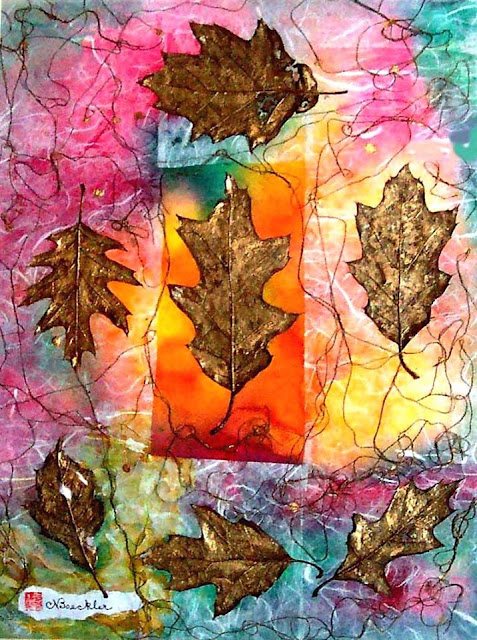 |
| Autumn Leaves, by Norma A. Boeckler |
Readers enjoyed the first episode about
- Autumn leaves and the Creation Garden, and I had one in 2016 -
- Finally, Autumn Leaves.
We have had unusually warm days, but fortunately a few frosty nights got the trees to start giving up their leaves.
I realized, about 30 years ago, that we should never take organic matter away from the garden. God mulches with leaves and plant debris, so we should too.
One neighbor delighted me by getting on his riding mower and driving over the leaf piles in the street. That really did nothing except blow the top leaves back into his neighbor's yard. But I waved, smiled, and coveted the new treasure.
Leaves on top of soil will be pulled down and reduced to food by earthworms, mites, and slugs. But leaves shredded by the lawnmower are already half-done, easier to compost, and unlikely to blow away. My Creation-wise neighbors simply mow the leaves into their lawn, a great combination of high nitrogen grass for decomposition and leaves to build the soil.
And it rained thoroughly to soak this flaky mass, all the better for shoveling and mulching the rose garden. Today I will get more into the front yard.
Observation shows that all leaves left in the yard will disappear by late spring. Sycamores like to hang around and blow around, because they have a rugged construction, almost like they are plastic coated. But they cannot withstand the effects of rain, cold, snow, freezing, mold, and soil life.
So I want as many leaves in the yard as possible. What does not rot into the soil by spring makes a good-looking mulch. The hunger of the soil is not for chemical fertilizer but for organic matter. One neighbor was sprinkling plants with chemical fertilizer while I was scooping his leaves and topsoil into my rose garden. Soil thief? Not at all. Top soil washes onto the sidewalk and into the street, so I recapture it.
When I cleaned the gutters, the debris coming out of the downspout looked just like black, rich potting soil - sold at gardening centers. Mine was free, discounting my labor costs. I put the rich mixture on top of the Blackberry patch, where I will rake additional leaves. I have harvested several berries from there, since Mrs. Robin thinks I am stealing her fruit. She emerges from the canes and looks at me the way a librarian does when I talk too loudly in that sacred space. She gets leaves for her nest there, too. She may pace around me in a fit, but she will not give up her building material.
 |
| Robin by Norma A. Boeckler |
If you wonder about the persistence of packing tape, you should look at a nest in the Mother of All Crepe Myrtles. Some old tape found its way into the nest as binding material. That makes me more determined to get dryer lint outdoors as soon as the winter thaws and add pieces of twine to the collection. Birds love the "trash" taken away by chemical gardeners. These clever engineers construct nests from ribbons, twigs, string, yarn, dryer lint, pieces of cardboard, colorful strips of plastic, and leaves.
Throw lengths of twine over a bush or lower tree limb and see how long they last in the early spring.
In the meantime, I spoil the insect eaters with suet in wire baskets. The woodpecker family, grackles, and starlings use suet as a substitute for bugs, but they continue to hunt for bug larvae all winter, where God conveniently stores them in bark and in bushes.
 |
| Let's kill all the clover. It spreads on its own, hurts no one, and collects usable nitrogen for the soil. And the flowers smell like bubble gum! |
